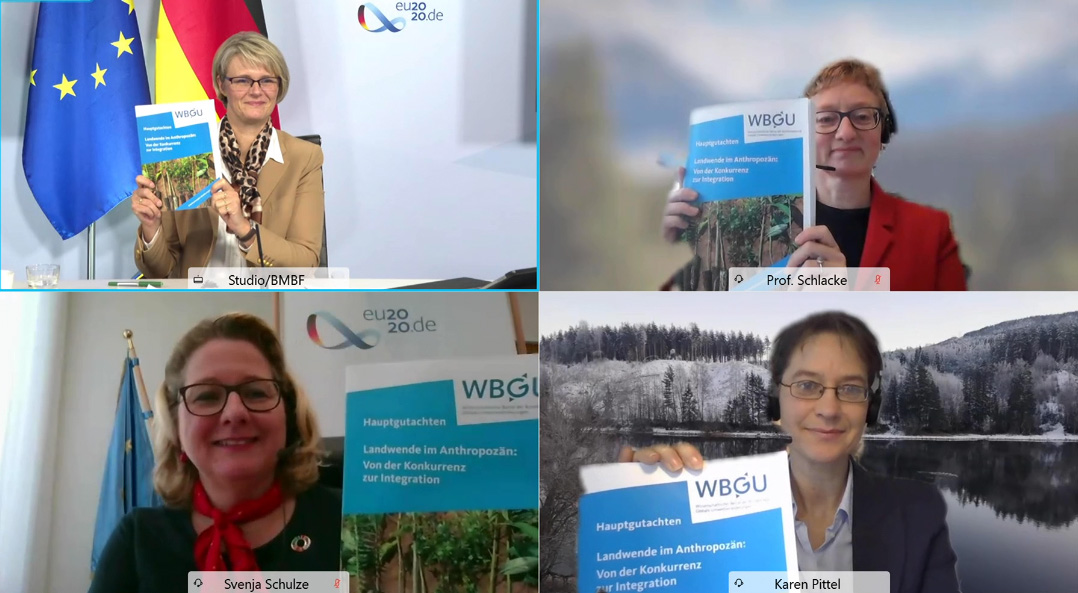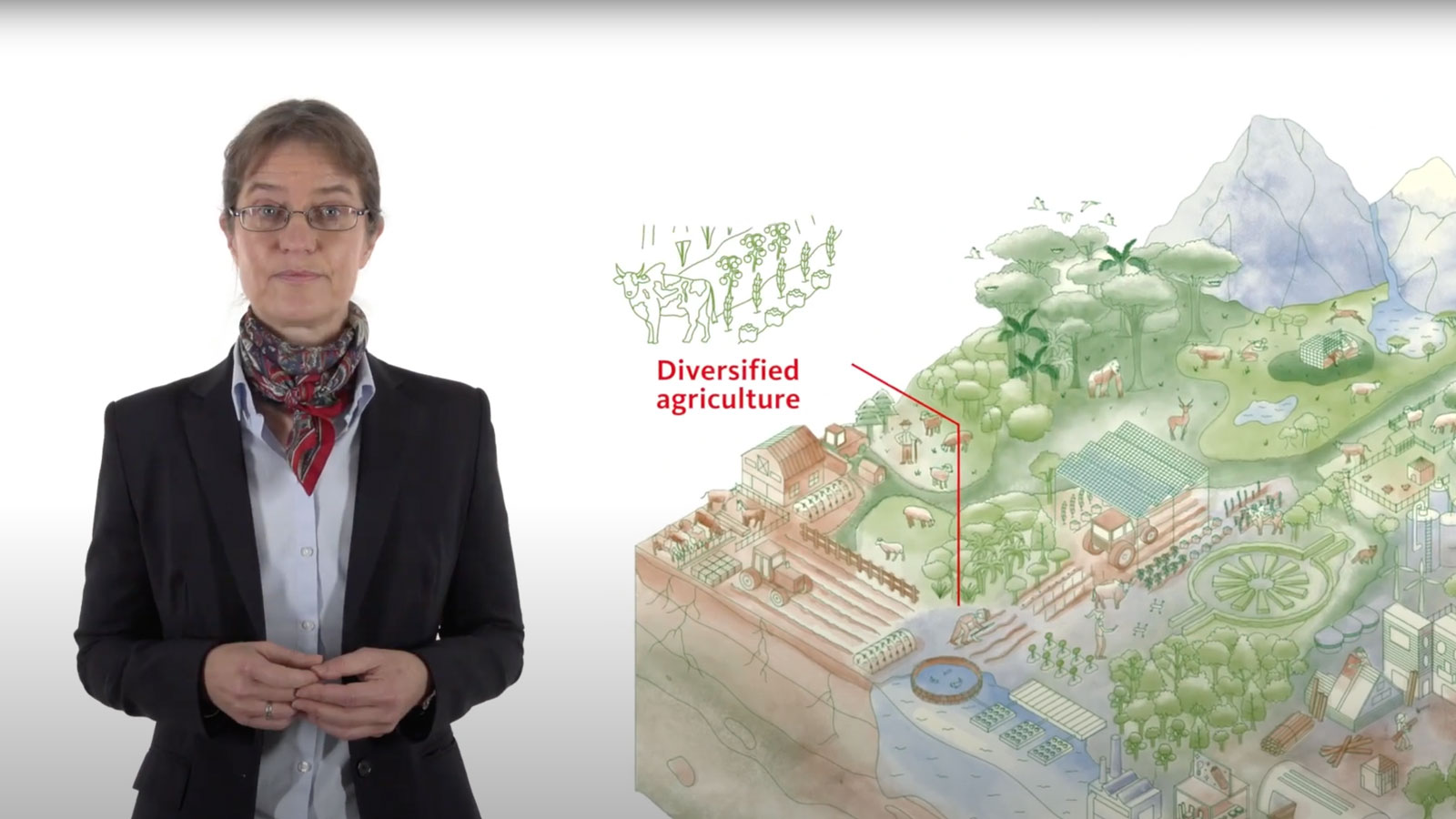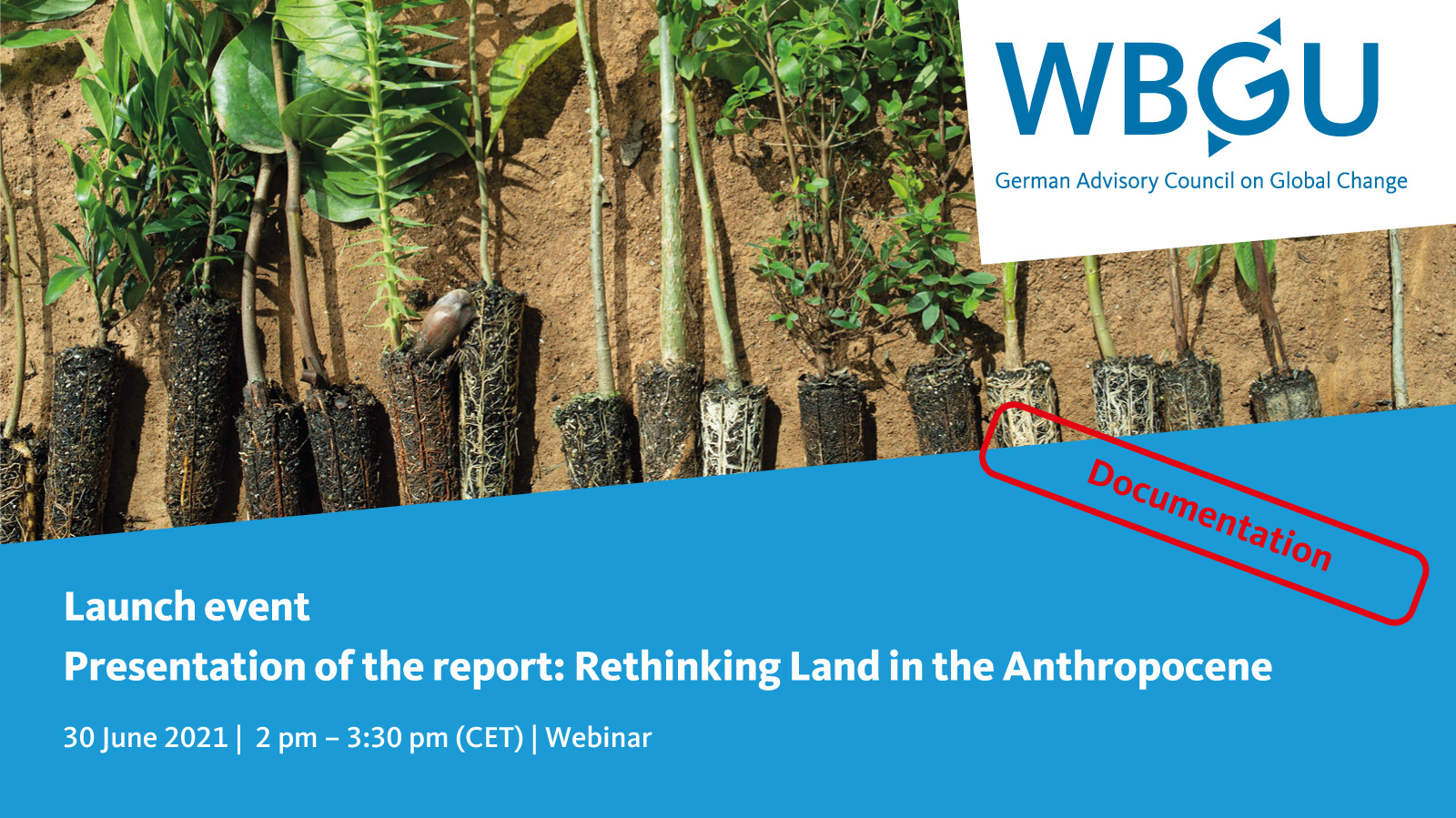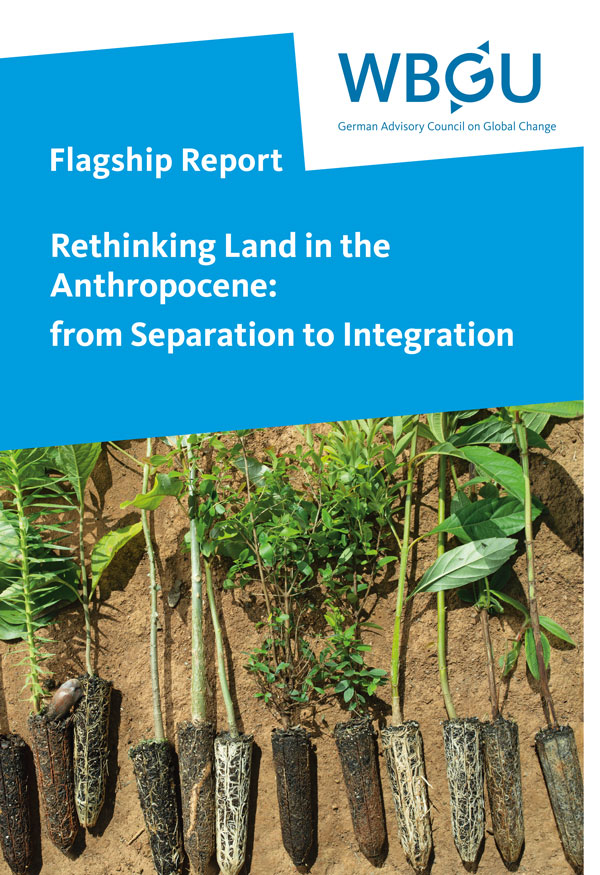
Rethinking Land in the Anthropocene:
from Separation to Integration

Only if there is a fundamental change in the way we manage land we can reach the targets of climate-change mitigation, avert the dramatic loss of biodiversity and make the global food system sustainable.
Overview
More about this topic
The WBGU proposes five multiple-benefit strategies illustrating ways of overcoming competition between rival claims to the use of land. These should be promoted by five governance strategies, especially by setting suitable framework conditions, reorienting EU policy and establishing alliances of like-minded states.
Land is the basis of human life. With climate change, the mass extinction of biological diversity and an often dysfunctional food system, we are experiencing three colliding global crises that are directly linked to the way we manage land. Yet the land and its biologically productive ecosystems are under more pressure than ever before. This is the starting point of the present report: Which strategies for managing terrestrial ecosystems are most suitable for defusing the existing competition between different forms of land use while simultaneously ensuring climate-change mitigation, biodiversity conservation and food security? How can transformative change towards sustainable land use be promoted and which actors need to be mobilized and become involved? What challenges does this pose for research and for Germany's role in global environmental and development policy?

Land resources under pressure
Humankind has already fundamentally transformed the terrestrial biosphere. Around the year 1700, most of the world's land was still largely in its natural state; today, however, only about 23% of the global land surface can be designated as wilderness. As convincingly shown by global assessments and progress reports in recent years, humanity is increasingly destroying this natural life-support system, partly as a result of the growing global demand for land and terrestrial ecosystem services. The pressure on terrestrial ecosystems from overuse and competition for use has never been greater than it is today. Around a quarter of the Earth's ice-free land surface is affected by human-caused degradation.

The trilemma of land use
An appraisal of international sustainability policy at the beginning of the 2020s makes for sobering reading. It looks as if the climate goals of the Paris Agreement can only be reached if more areas of land are used to extract carbon dioxide from the atmosphere, which not only offers opportunities, but also involves considerable risks. The global food system is in crisis: the food security of a quarter of humanity is under threat, and another quarter suffers from unhealthy overconsumption. Furthermore, the external effects of industrial agriculture are threatening natural life-support systems. Not least, biodiversity is currently experiencing a dramatic mass extinction worldwide.
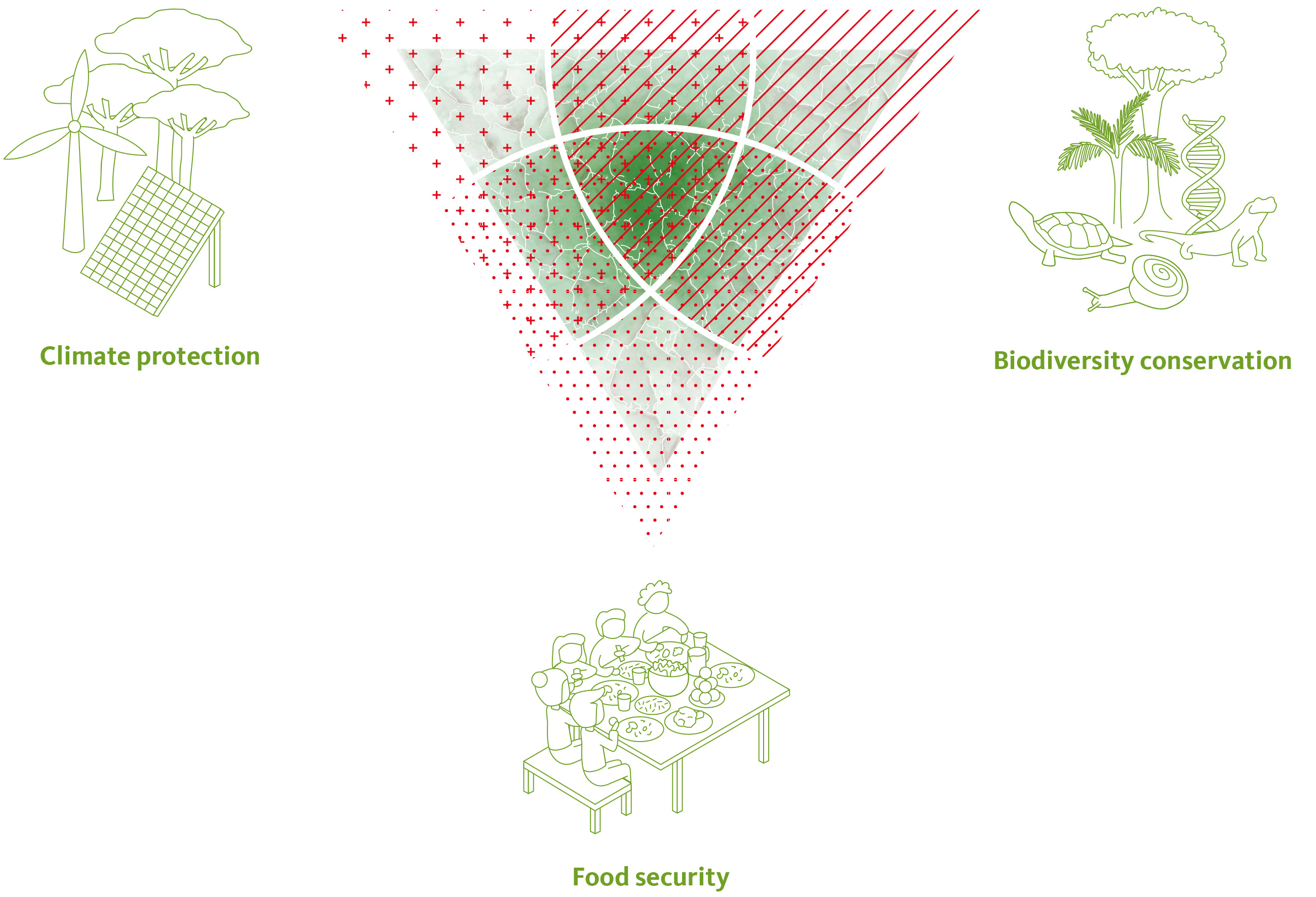
The diverse demands made on land for the purposes of climate-change mitigation, food security and the conservation of biological diversity are already in competition with each other, and land degradation will have a negative impact on all three aspects in the short or long term. The WBGU calls this the 'trilemma of land use' (see illustration), because, at first glance, it appears that any one of these challenges can only be met at the expense of the other two. Finding solutions here will be decisive for sustainable land stewardship.

From separation to integration
The WBGU therefore urges a systemically substantiated, sustainable approach to land stewardship, which is an important key to the Great Transformation towards Sustainability. Ecosystems and their diverse services are essential bases for human life and economic activity and deserve to be at the centre of attention, whereby remote effects on land-use changes and land degradation (telecouplings) – e.g. by material cycles or the world trade in agricultural goods – must also be taken into account.
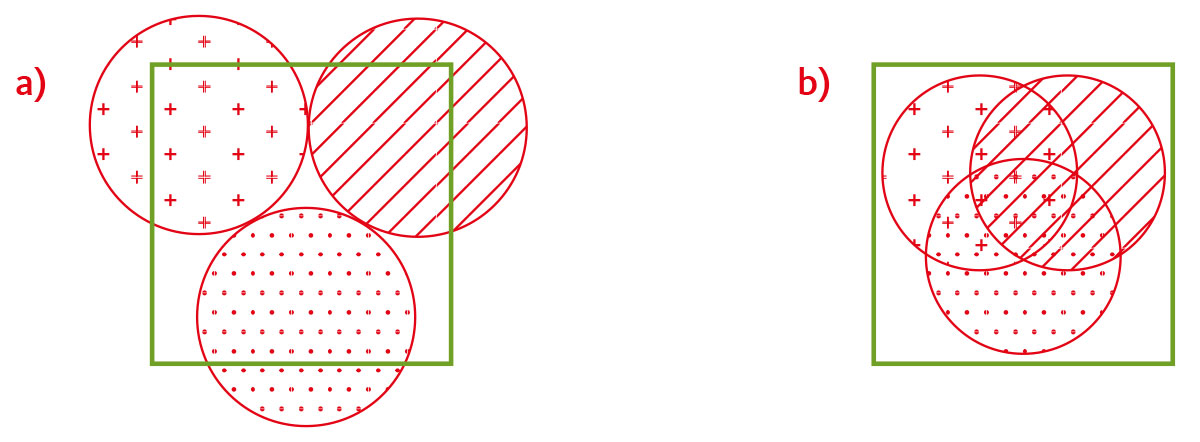
Land is a global commons: humankind must assume responsibility for land in order to mitigate climate change, conserve biodiversity and safeguard food security; it must discharge this responsibility nationally and enforce it internationally. The focus should be on halting the destruction of terrestrial ecosystems and on investing massively in their conservation and restoration. Globally sustainable land stewardship is a prerequisite for compliance with planetary guard rails and for meeting the UN Sustainable Development Goals (SDGs). An integrated form of land stewardship that combines the multiple goals and, where possible, realizes them on one and the same area of land can help overcome competition.

Five multiple-benefit strategies for sustainable land stewardship
To this end, the WBGU has developed five examples of multiple-benefit strategies (see illustration).
First, the efforts to restore terrestrial ecosystems should be massively expanded. The target set by the Bonn Challenge of restoring 350 million hectares of degraded land by 2030 should be not only achieved but significantly extended. The focus should be on the restoration of biodiverse and site-appropriate forests, wetlands and grasslands, while simultaneously removing CO2 from the atmosphere as an additional benefit. Yet removing CO2 from the atmosphere is no substitute for the necessary massive reduction in CO2 emissions. In climate-change-mitigation strategies, therefore, there should be no overall climate-neutrality target in which CO2 removal is offset against CO2 reduction; rather, removal should be pursued independently.
Second, effective, well inter connected protected-area systems form the backbone of ecosystem protection. The expansion and upgrading of protected areas are crucial prerequisites for defusing the global biodiversity crisis. Terrestrial protected-area systems should be extended to cover 30% of the Earth's surface, and internationally agreed quality criteria should be consistently applied. This, too, offers the additional benefits of contributing to climate-change mitigation and preserving the long-term potential for food security.
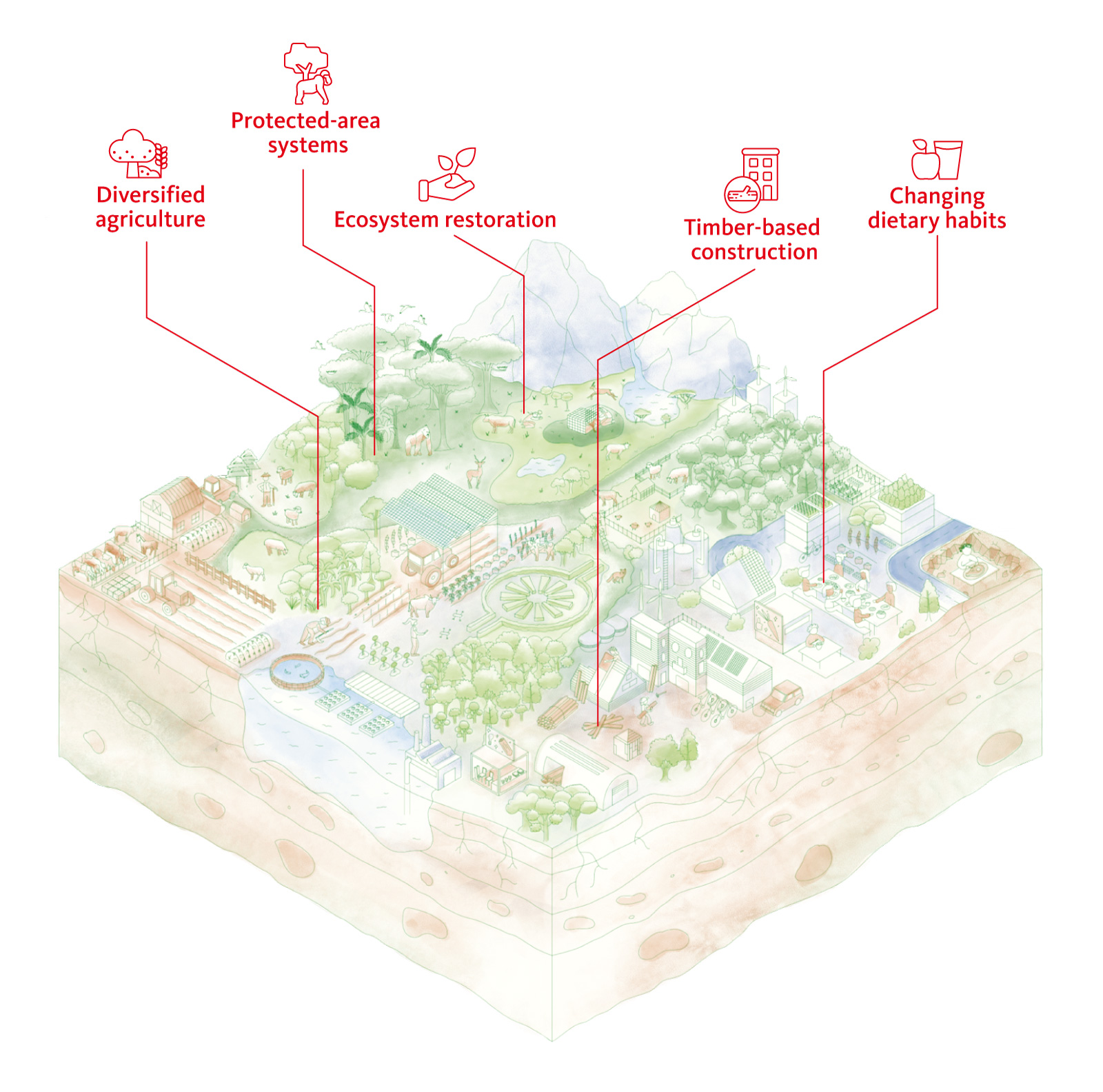
Third, promoting diversity-based agriculture is another multiple-benefit strategy that can help bring about a global transformation of land use. EU agricultural policy should turn away from industrial farming methods by carrying out a comprehensive ecological transformation. This promotes food security, climate-change mitigation and biodiversity conservation simultaneously. The example of sub-Saharan Africa shows how diversification can lead to a sustainable increase in production. Global agricultural trade can also be directed in such a way that it promotes multiple benefits.
Fourth, the transformation of dietary habits in industrialized countries, especially by reducing the proportion of animal products consumed, has promising potential for easing the pressure on terrestrial ecosystems. Orientation towards the 'Planetary Health Diet' should become a fixed principle of nutrition guidelines and should also be recommended by the Federal Government.
Fifth, when shaping the bioeconomy, preference should be given to applications in which biomass – and thus also the carbon it contains – is stored for a long time. Building with timber is an example of effective ways of long-term carbon storage. However, the wood for this must come from site-appropriate, sustainable forestry. To this end, a global 'mission to promote sustainable construction' should be initiated with international partners and linked to the EU's initiative for a 'New European Bauhaus'.
![[Translate to english:] Foto: Phil McIver, The watcher](/fileadmin/user_upload/wbgu/publikationen/hauptgutachten/hg2020/05_Governance-Strategien_hero_1920x550.jpg)
Five governance strategies for the global transformation of land use
Many actors need to be involved in the implementation of the multiple-benefit strategies, for land has the character of a global commons: it requires people worldwide to take responsibility for maintaining healthy and productive ecosystems, which are ultimately the basis of life for us all:
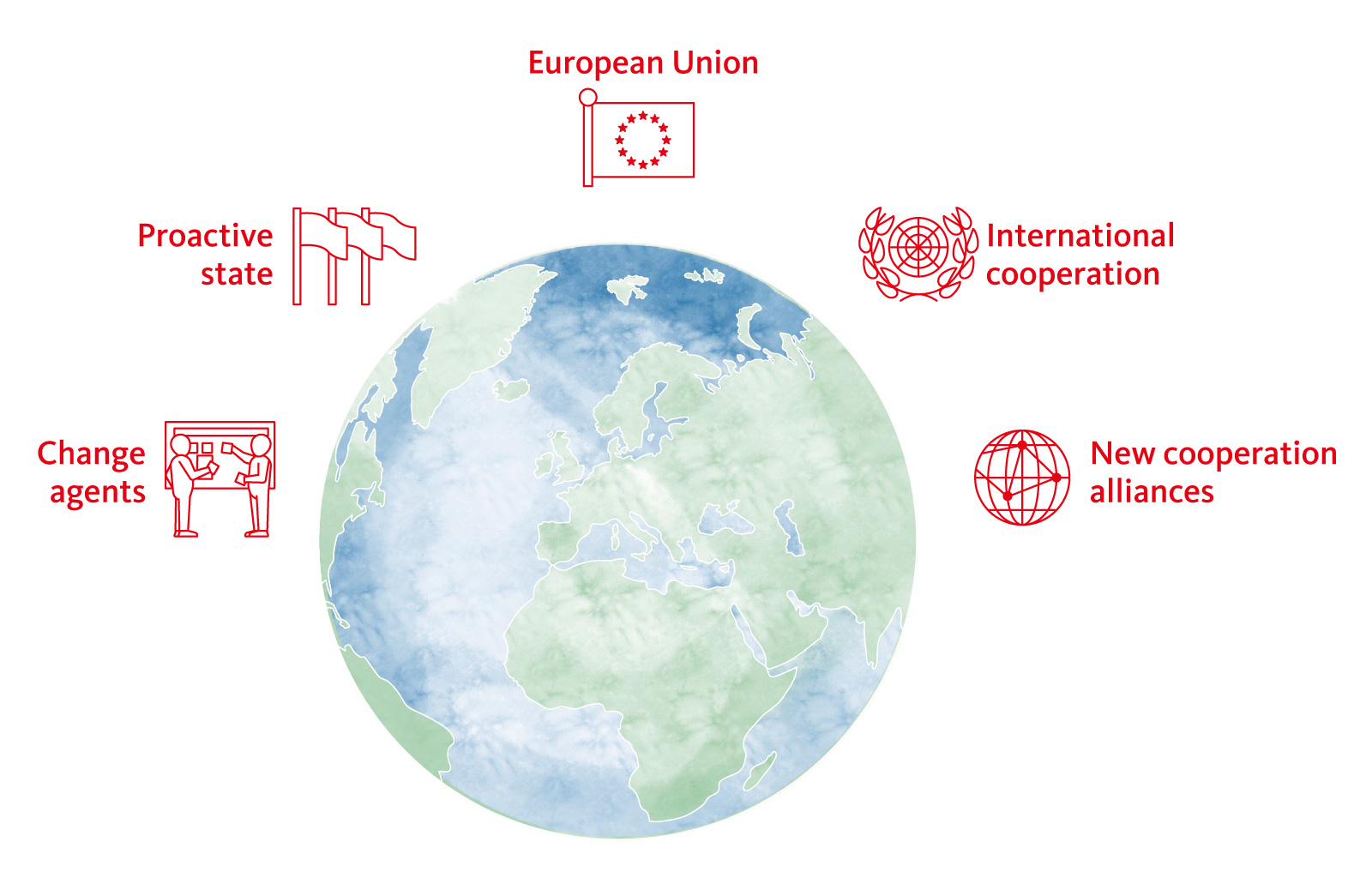
- First, support should be given to change agents: i.e. people and institutions that try out new forms of sustainable land use, practice them and propagate them as pioneers.
- Second, states should create framework conditions to prevent the further destruction of ecosystems through unsustainable land use. These can be price incentives, sustainability standards or subsidies for sustainable land use. At the same time, society should reward the conservation and restoration of ecosystems.
- Third, the European Union should press ahead with a transformation of land use towards sustainability as part of the European Green Deal – all the more so after the disappointing results of the reform of the Common Agricultural Policy (CAP). The CAP should be further developed into a Common Ecosystem Policy.
- Fourth, international cooperation on land management should be improved and a 'Global Land Summit' convened in the form of a joint conference of the parties to the UN conventions on climate, biodiversity and desertification.
- Fifth, the WBGU recommends that, in order to strengthen existing international efforts, new cooperation alliances should be formed by like-minded states and/or sub-national regions using new forms of multilateral cooperation.
- These can be regional alliances that implement an integrated landscape approach, also across borders. Regional alliances of sub-national regions can, for example, establish regional circular economies and value chains; they can further develop existing biosphere reserves into forerunners of integrative landscape areas, or set up regional innovation hubs for sustainable farming methods.
- Another model for a new cooperation alliance is a global supranational alliance of like-minded states joining together for a global land-use transformation.
- Finally, we propose the creation of conservation alliances for valuable ecosystems. Here, both states and private actors join forces with the aim of conserving, restoring and jointly leasing valuable ecosystems in third countries. These third countries should also be part of the conservation alliance.
More on the Subject
Voices to this Report
The German Advisory Council on Global Change’s recent report, ‘Rethinking Land in the Anthropocene: from Separation to Integration’, makes it abundantly clear that we need a fundamental change in how we manage the land to limit climate change, reverse biodiversity loss and create sustainable food systems. Healthy land is finite, but changes in consumer and corporate behaviors, combined with better land use planning and management, can help meet the demand for essential goods and services without compromising land resources. This report presents a clear path toward climate change mitigation, ecosystem protection and food systems sustainability through better land management.
Ibrahim Thiaw, Executive Secretary der United Nations Convention to Combat Desertification (UNCCD)
PDF and eBook Downloads
Gutachten: Landwende im Anthropozän
- Download: Vollversion (PDF 21 MB)
- Download: Zusammenfassung (PDF 6 MB)
- Download: Zusammenfassung (eBook, epub 7 MB)
Flagship Report: Rethinking Land in the Anthropocene
- Download: Full Version (PDF, 26 MB)
- Download: Summary (PDF 6 MB)
- Download: Summary (eBook, epub 7 MB)
Commissioned Expert's Studies
External expert studies are comissoned by WBGU, the responsibility for the content rests with the author.
- Download: Jun.-Prof. Dr. Cathrin Zengerling, LL.M.: Internationales Handelsrecht und nachhaltige Landnutzung aus der Perspektive von Klimawandel und Entwicklung (PDF 1,8 MB)
- Download: Jun.-Prof. Dr. Cathrin Zengerling, LL.M.: Strengthening Climate Protection and Development through International Trade Law (PDF 1.8 MB)

